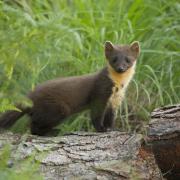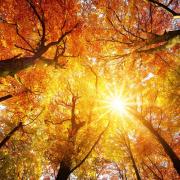What do you picture when you hear the word meadow? Whatever scene you see, it probably has a swathe of colourful flowers, hopefully buzzing with bees and other insects. But it’s a word that can mean different things to different people.
Traditionally, a meadow is a grassy area left to grow until late summer, when it’s cut for hay. Once the hay has been removed, it may be grazed by cows or sheep until spring, when the animals are taken away to give plants more freedom to grow. Grasses shoot up and flowers thrive, creating a beautiful mosaic of colour. As this cycle repeats year on year, meadows become richer with different plants and animals.
Now the word meadow is often used more loosely, applied to any area where grasses and wildflowers are given the opportunity to grow through spring and summer – from pastures to wild patches in our gardens. Some maintenance is needed, through grazing or strategic mowing, to keep conditions right for a wide variety of flowers. Whatever we call them, grasslands rich with native wildflowers are an essential part of our landscape – and that includes our gardens!

Bloomin’ beautiful
Flowers are the heart of any meadow, the star attraction. Each meadow, or wildflower grassland of any description, will have its own mix of species, shaped by the conditions in which they grow. Two of the biggest influences are climate and soil type. The cooler, wetter conditions in upland grasslands (above 300m) favour different species to the warmer, drier and less exposed lowland grasslands.
Soil type is just as important. There are three main categories we apply to grasslands. Calcareous grasslands are found on shallow, base-rich soils like those over areas of chalk and limestone. Neutral grasslands occur where there are clay or loamy soils. Finally, acidic grasslands grow from sands, gravels and siliceous rocks. Each has its own specialist grasses and wildflowers.
Buzzing with life
Grasslands shelter a wealth of insects and other invertebrates, like crickets, grasshoppers, bees, beetles and spiders. Moth and butterfly caterpillars feed on the leaves of grasses and flowers. As with the plants themselves, some have niche tastes in their habitat. The mountain ringlet, for example, is only found on mountainside grasslands in Scotland and Cumbria, where they feed on mat-grass. Others, like the meadow brown, are less picky – their caterpillars feast on a variety of grasses in meadows of different soil types.
Once the caterpillars have fattened up and transformed into adults, many will sip nectar from the colourful flowers. Visit on a sunny summer day and you should see butterflies on the wing – but look out for moths, too. Six-spot burnet moths flicker from flower to flower, with a fondness for thistles and knapweeds. They’re glossy black, with six red spots splashed across each forewing. They’re a common sight on a wide range of grasslands. Chimney sweepers are also black, with a thin white fringe on their wing tips. They favour damp grasslands in the north, but prefer chalk or limestone soil in the south.

A buffet for birds
With so many insects living in meadows, they’re great places to see the birds that like to feed on them. Look out for swifts, swallows and martins swooping through the air above, scooping up flying insects to carry back to their hungry chicks.
Skylarks nest beneath tufts of grass. They start their chicks off on an insect diet, but soon start to supplement it with seeds. They’re secretive around the nest, but males are easily heard as they sing in flight, high in the sky.
It’s not just insects and seeds that draw hungry birds to our grasslands. The tangle of grasses and plants provides perfect shelter for voles. During the day, kestrels hover overhead, scanning for a flash of movement that might betray one scurrying through the grass. At night, they’re replaced by barn owls, hoping to hear the rustle of a roaming vole.
Sadly, meadows have become a much rarer sight across the UK since the middle of the 20th century. They’ve been lost as farming practices have changed, or destroyed by developments. Luckily, some magnificent meadows still exist as nature reserves. Ten years ago, the Coronation Meadows project was launched to identify species-rich meadows to act as seed donors to improve other sites. In the decade since, 101 wildflower meadows have been created or restored as a result.

Cotswold Great – Swifts
This month, swifts will arrive for the summer, after flying thousands of miles from Africa where they spent the winter. These high fliers spend most of their lives in the sky, only ever stopping to nest. They even sleep on the wing!
Swifts, like swallows and martins, feed on flying insects, which they catch in a pouch at the back of their throat when mid-air. These insects are bound together into a pellet known as a bolus, which can be regurgitated and fed to chicks.
Unfortunately, these extraordinary birds are globally threatened, and they have seen big declines in their populations. You can help these arrows of the sky by adding a swift nestbox to your home, so that future generations can enjoy the sight of a soaring swift in the Cotswold skies.
Seven bumblebees to see this summer








Gardening – No Mow May
Lock the mower away and let the wildflowers bloom this month to help your local butterflies, bees, and other pollinators. Every flower counts. Just five daisies, two dandelions and six buttercups together provide enough nectar to support a honeybee a day.
As well as helping pollinators, the birds and hedgehogs in your area will benefit from the insects in your lawn who make the most of the nectar source and shelter.
If you'd like to let your neighbours and passers-by know why your local patch is going wild, you can download our free signs to inspire others. Get your free sign by heading to www.gloucestershirewildlifetrust.co.uk/no-mow .



























